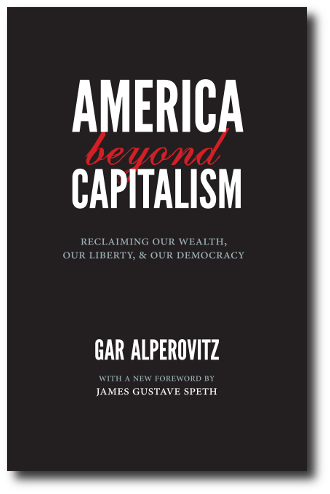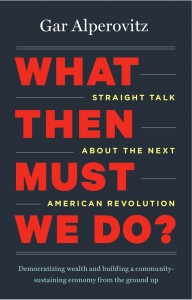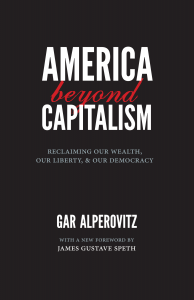(This article first appeared in Tikkun Magazine, Winter 2011)
 Workers at Ohio Cooperative Solar (left) and Evergreen Laundry take part in a strategy to capture ever-greater shares of spending in health, energy, and other key sectors for an integrated, large-scale network of worker-owned businesses. PHOTOS: JANET CENTURY.
Workers at Ohio Cooperative Solar (left) and Evergreen Laundry take part in a strategy to capture ever-greater shares of spending in health, energy, and other key sectors for an integrated, large-scale network of worker-owned businesses. PHOTOS: JANET CENTURY.
by Gar Alperovitz
We are entering one of the greatest long-term crises in American history, one that could potentially lead to a breakdown and radical move to the right. Traditional liberalism is stalemated in many areas and limited in others to reducing the pain whenever possible. War continues. The era is unusual; economic stagnation is present, yes, but Depression-style crisis, the kind that may generate a quick response, does not appear likely. Proudhon once wrote: “Decay, decay … All the traditions are worn out, all the creeds abolished but the new program is not yet ready….This is the cruelest moment in the life of societies.”
My own work has been a long, long attempt to answer two questions: First, “If you don’t like corporate capitalism and you don’t like state socialism, what do you want?” Second, “And how can we get from here to there?” In part following Martin Buber, in part following teachers like William Appleman Williams and Joan Robinson, my answers — in books and in projects — have aimed at an “evolutionary reconstructive” approach, starting in the here and now, to rebuild and democratize in very practical ways the ownership and nature of the economy, from the bottom up. My hope is that some of these ideas, and some of these projects, may contribute to a broader movement-building politics that can take us past the dead ends we now face.
I’d like to offer one illustration and one comment about theory. Our Democracy Collaborative team is working in Cleveland, Ohio, to help create the Evergreen Cooperative Development Fund. The goal is not just one cooperative but rather an integrated, large-scale network of worker-owned businesses financed by a revolving fund designed to continuously expand the network and to keep jobs anchored in the community. The strategy aims to capture ever-greater shares of spending in health, energy, and other key sectors in a way that both changes ownership patterns and helps stabilize the local community economy. The approach is also thoroughly “green”: Ohio Cooperative Solar, one part of the complex, installs solar panels on the roofs of the city’s largest nonprofit health, education, and municipal buildings.
But the goal is not simply green jobs; it is “green ownership.” Nor, from my perspective, is the goal simply building cooperatives — it is thinking through the requirements of a larger systemic theory and vision that is practical, democratic, and achievable, even if over a long time span. The design principles of the Cleveland effort suggest principles that take us beyond both traditional capitalism and traditional models of socialism.
Consider, for instance, what might happen if the stock the government and union currently own in General Motors were ultimately used to reorganize the company along full or joint worker ownership lines — and if the new GM product line were linked to a serious plan to develop the nation’s mass transit and rail system, all of the funding for which will inevitably come from taxpayers in any event. Along with many other movement-building efforts, such efforts, starting locally but thinking far ahead, suggest ways that I hope can one day help move our own thinking — and ultimately our politics — forward to and through the deepening crisis in a positive, community-affirming way.
 AMERICA BEYOND CAPITALISM
AMERICA BEYOND CAPITALISM



 Agenda
Agenda  Posterboard
Posterboard 